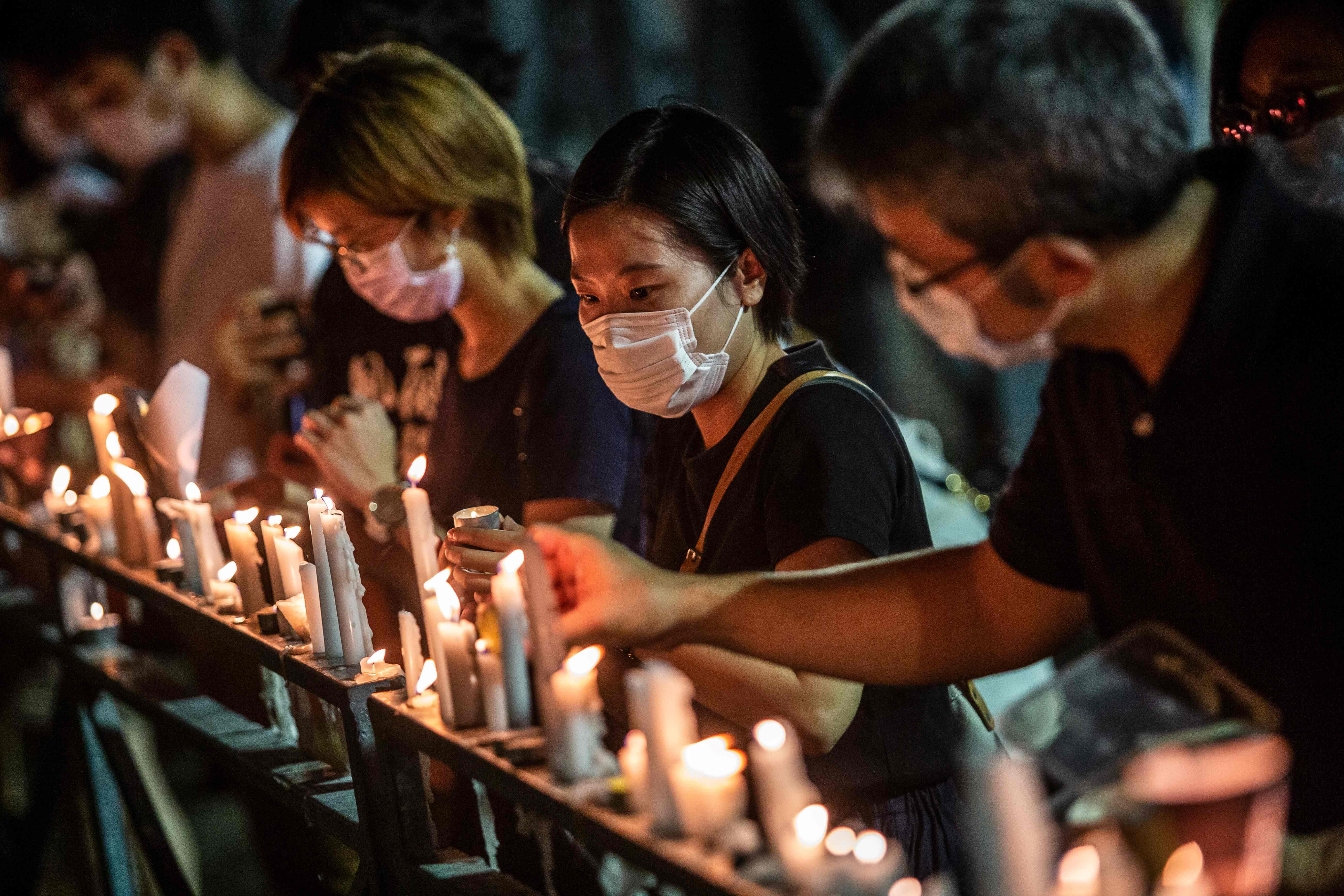Activists move to preserve historical records of Tiananmen amid China’s pro-democracy crackdown in HK
Experts view the crackdown on the Hong Kong alliance and the June fourth museum as a sign that the “One Country, Two Systems” model has been destroyed, writes William Yang


Your support helps us to tell the story
From reproductive rights to climate change to Big Tech, The Independent is on the ground when the story is developing. Whether it's investigating the financials of Elon Musk's pro-Trump PAC or producing our latest documentary, 'The A Word', which shines a light on the American women fighting for reproductive rights, we know how important it is to parse out the facts from the messaging.
At such a critical moment in US history, we need reporters on the ground. Your donation allows us to keep sending journalists to speak to both sides of the story.
The Independent is trusted by Americans across the entire political spectrum. And unlike many other quality news outlets, we choose not to lock Americans out of our reporting and analysis with paywalls. We believe quality journalism should be available to everyone, paid for by those who can afford it.
Your support makes all the difference.Merely weeks after several civil society organisations in Hong Kong announced their disbandment, the Hong Kong government has turned the focus of their crackdown to the Hong Kong Alliance, known for organising the annual Tiananmen candlelight vigil in the city.
On Wednesday, a court in Hong Kong handed nine activists and former lawmakers a prison sentence of up to ten months over their participation in last year’s banned Tiananmen Square vigil, saying they have taken part in an unauthorized assembly
The Hong Kong Alliance had previously refused to comply when the city’s police demanded they hand over financial records and detailed information about its members, citing the National Security Law (NSL). Instead, they handed the police a letter explaining their decision not to cooperate with the authorities.
Then last Wednesday, five members of the alliance’s standing committee were arrested by police and charged with failing to comply with the request under NSL. On Thursday, the alliance said its chairperson Lee Cheuk-yan, vice chairpersons Albert Ho and Chow Hang Tung had all been charged with subversion of state power, a crime that has often been used to target dissidents in China.
On the same day, police from Hong Kong’s national security unit raided the June Fourth Museum, which was run by the Hong Kong Alliance, taking away logos, signs and other materials. The museum had previously been shut down in June after Hong Kong’s Food and Environmental Hygiene Department launched an investigation into its license.
Experts view the crackdown on the alliance and the museum as a sign that the “One Country, Two Systems” model has been destroyed. “One of the most important symbols of Hong Kong remaining a place politically distinct from its mainland neighbours was that people could gather there in large numbers on the anniversary of the June Fourth Massacre in Beijing in 1989 and talk freely about the meaning of the many acts of protests and repression that took place across China that year,” said Jeff Wasserstrom, a historian of modern China at the University of California, Irvine.
It used to be a beacon of freedom and democracy, but now it has become a very large prison
Wasserstrom says by making the vigil illegal in Hong Kong and Macau, as well as launching more repressive actions against an organisation known for defending the tradition related to the Tiananmen Square Massacre, the Chinese government proves all that really remains of the “two systems” are some differences in how people can make and spend money.
Along with the crackdown on civil society groups in Hong Kong, some Tiananmen student leaders and participants view the museum raid and moves against the Hong Kong Alliance as an attack on efforts to preserve memories related to the massacre.
“The Hong Kong Alliance has been one of the most important organisations that are dedicated to preserving the spiritual legacy of the Tiananmen Square protests,” said Zhou Fengsuo, a Tiananmen student leader who now lives in the United States.
The museum is part of the confrontation of the CCP’s efforts to manipulate public memory about the Tiananmen Massacre, and it is also a project that documents the CCP’s crackdown on human rights as well as Chinese people’s resistance
“This alliance has been the core of the democratic movement in Hong Kong, and it has been the main platform for the annual candlelight vigil and other activities, including support for Chinese prisoners of conscience,” he added.
Zhou explains that since the alliance has accumulated so much influence over the years that they are a thorn in the side of the Chinese Communist Party (CCP.) The CCP thinks that it must be eliminated in order to comply with the Chinese government’s political ideology.
Part of the efforts to preserve memories related to the Tiananmen Square protests is the creation of an online version of the June Fourth Museum, which includes digital backups of the museum’s collections and records of the movement.

“While the thought of creating a digital version of the museum had been brewing before the anti-extradition bill movement in 2019, the introduction of the NSL accelerated the process of establishing the digital archive,” said Chang Ping, a prominent Chinese author and one of the curators of the online archive.
“The museum is part of the confrontation of the CCP’s efforts to manipulate public memory about the Tiananmen Massacre, and it is also a project that documents the CCP’s crackdown on human rights as well as Chinese people’s resistance,” he added.
According to Chang Ping, Hong Kong was a very important force during the student-led movement in 1989, especially the “Operation Yellowbird,” which facilitated the escape of several Tiananmen student leaders to other countries via Hong Kong. The operation was spearheaded by the Hong Kong Alliance and ensured that many pro-democracy activists were rescued.
“Hong Kong provided strong support to the pro-democracy struggle in China, which gives the CCP a reason to launch a suppression against Hong Kong,” he said.
Zhou Fengsuo says it was clear during the anti-extradition bill movement in 2019 that if the movement couldn’t succeed, Hong Kong will begin its process of “mainlandization,” which refers to the process of Hong Kong becoming more and more similar to China in all aspects. “The CCP has gone crazy in many aspects, but one thing surprising is the severity of the NSL’s punishments,” said Zhou.
“The fact that the Chinese government decides to enforce such a law in Hong Kong, where there is space for civil liberties and freedom, shows the nature of this regime. It will use all its power to extinguish the freedom that people enjoy, and Hong Kong is the first target of its expansion. It used to be a beacon of freedom and democracy, but now it has become a very large prison,” he added.
These preservation efforts are valuable, especially perhaps when it comes to the mainland events of 1989, as collections relating to those do exist in other places, but to events in Hong Kong itself
Chang Ping adds that all the transformation that China went through over the last 70 years under the CCP’s rule will now take place in Hong Kong in a more condensed way. “This is the future that Beijing has designed for Hong Kong,” he told the Independent.
Despite the bleak outlook for Hong Kong’s future, some experts think the preservation of historical records will still be important for the city. “These preservation efforts are valuable, especially perhaps when it comes to the mainland events of 1989, as collections relating to those do exist in other places, but to events in Hong Kong itself,” said Jeff Wasserstrom from the University of California, Irvine.
Since there were also large-scale public events in Hong Kong and Macau in 1989, which were expressing solidarity with activists in Beijing, Wasserstrom thinks those records are both an important part of history for the 1989 protest and Hong Kong.
“There is a real danger of a full record of those being lost, as the CCP is trying to impose an orthodox vision of the past in Hong Kong,” Wasserstrom said. “In a sense, the annual vigils and related events since 1989 are an important part of Hong Kong’s history, and preserving those again is significant.”
Join our commenting forum
Join thought-provoking conversations, follow other Independent readers and see their replies
Comments